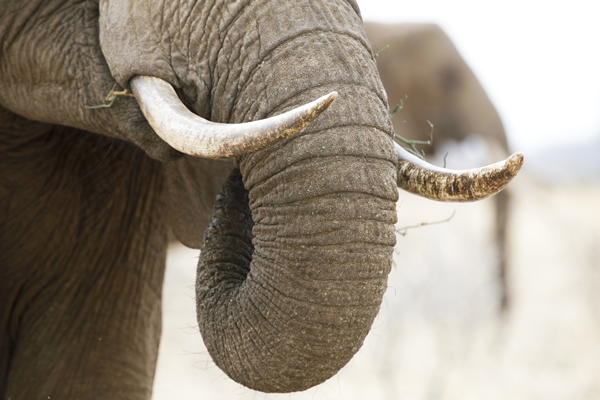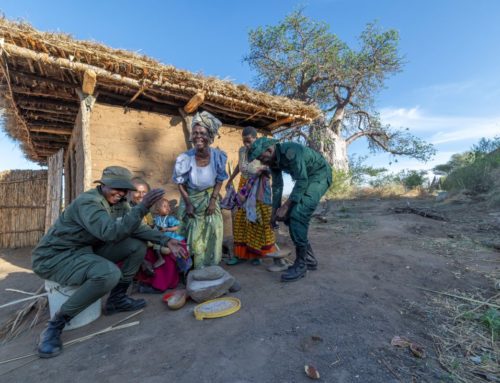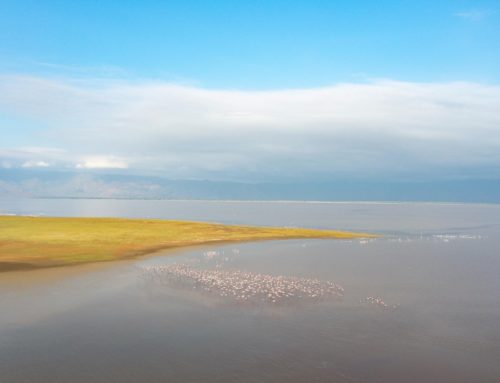 Late one morning in July, two Honeyguide field officers trekked along the perimeter of the famed Kitenden Corridor, which runs down through the western foothills of Mount Kilimanjaro. The officers, as led by Pascal Simon, had simply set out to collect data on crop damage caused by elephants among the farms that border the corridor.
Late one morning in July, two Honeyguide field officers trekked along the perimeter of the famed Kitenden Corridor, which runs down through the western foothills of Mount Kilimanjaro. The officers, as led by Pascal Simon, had simply set out to collect data on crop damage caused by elephants among the farms that border the corridor.
That’s when they came across two Maasai herders grazing their cattle upon the tufts of grass spread throughout Kitenden’s thickets. After the standard greetings and shaking of hands, the herders informed Honeyguide’s officers of a fresh carcass nearby.
“There is a dead elephant up the mountain,” said one of the herders in Maa, the language of the Maasai, and then he pointed in the direction of the scene. “Just 200 maybe 300 meters that way.”
So Pascal and his colleague immediately raced uphill to try and find the fallen pachyderm. But then they encountered something even more unexpected.
Kitenden provides open passageway for elephants and many other wild animals migrating between Africa’s greatest mountain and the plains and wilderness of the Enduimet Wildlife Management Area and also beyond to Amboseli National Park and its surrounding group ranches in Kenya. Both rangers from Kilimanjaro National Park and Honeyguide-supported rangers from Enduimet help protect the corridor, as requested by the District of Longido.
Currently, Honeyguide, which is funded by and manages the projects of Big Life Foundation in northern Tanzania, also works closely with Enduimet and its villages to protect another critical resource — communities’ farms. Just as July and August serve as the harvest season so they become the peak months for elephants to raid the fields of maize, beans, and other crops in countless farming communities that fall alongside conservation areas. A small herd of elephants can wipe out the vast majority of a farmers’ crops overnight.
Through the generous support of the USAID/PREPARED project, Honeyguide has developed a Human-Elephant Conflict Toolkit and trained rangers and community volunteers on how to safely deter elephants from raiding farms. (Look for an upcoming feature story on this program via Honeyguide’s website.)
Honeyguide also rigorously monitors and collects data on all of its initiatives, using a range of different methods, tools, and technologies, including SMART conservation software and Open Data Kit (ODK).
Thus, on that morning and beside the Kitenden Corridor, Pascal and his fellow officer had been assessing the damage and entering data into their smartphones using ODK when they received the news about the dead elephant.
Once the Honeyguide officers ran about 300 meters up Mount Kilimanjaro, they could find no sign of an elephant carcass. But they soon did spot two local youths much farther up the mountain.
As soon as the youths saw the Honeyguide officers below, they sprinted deeper into the forest. Pascal gave chase but the young men already had too much of a head start to be caught.
When Pascal arrived at the point where the men had first been spotted, he did find something else — two small elephant tusks that had been abandoned during the pursuit.
Pascal turned over the tusks to Enduimet WMA administrators who will keep them in a secured lock-up room until the Wildlife Division authorities can come and take them into their possession. An investigation is ongoing to determine whether or not the elephant died of natural causes. Some authorities speculate that the youths spotted at the scene had, in fact, hidden the tusks in the wilderness, left them there for weeks, and then at that very moment had gone to retrieve the ivory when they crossed paths with Honeyguide’s officers.
An update to this story will be posted as more information is verified. One thing is clear: due to the increasingly positive relationship Honeyguide and Enduimet have developed with communities through various programs, many village members are clearly more willing to share critical information that, in this case, has led to illegal ivory staying off the market.






